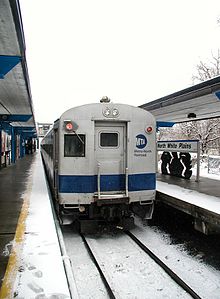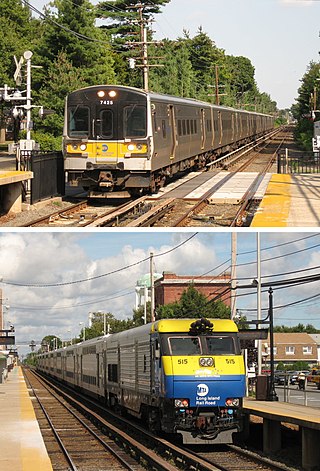
The Long Island Rail Road, often abbreviated as the LIRR, is a railroad in the southeastern part of the U.S. state of New York, stretching from Manhattan to the eastern tip of Suffolk County on Long Island. The railroad currently operates a public commuter rail service, with its freight operations contracted to the New York and Atlantic Railway. With an average weekday ridership of 354,800 passengers in 2016, it is the busiest commuter railroad in North America. It is also one of the world's few commuter systems that runs 24/7 year-round. It is publicly owned by the Metropolitan Transportation Authority, which refers to it as MTA Long Island Rail Road. In 2023, the system had a ridership of 75,186,900, or about 276,800 per weekday as of the first quarter of 2024.

Metro-North Railroad, trading as MTA Metro-North Railroad, is a suburban commuter rail service operated by the Metropolitan Transportation Authority (MTA), a public authority of the U.S. state of New York. Metro-North serves the New York Metropolitan Area, running service between New York City and its northern suburbs in New York and Connecticut, including Port Jervis, Spring Valley, Poughkeepsie, Yonkers, New Rochelle, Mount Vernon, White Plains, Southeast and Wassaic in New York and Stamford, New Canaan, Danbury, Bridgeport, Waterbury, and New Haven in Connecticut. Service in Connecticut is operated under contract with the Connecticut Department of Transportation. Metro-North also provides local rail service within the New York City boroughs of Manhattan and the Bronx.

A bilevel car or double-decker coach is a type of rail car that has two levels of passenger accommodation as opposed to one, increasing passenger capacity.
The St. Louis Car Company was a major United States manufacturer of railroad passenger cars, streetcars, interurbans, trolleybuses and locomotives that existed from 1887 to 1974, based in St. Louis, Missouri.
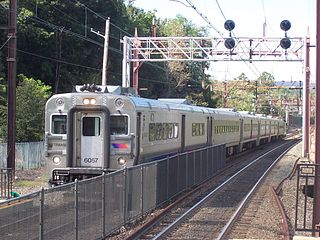
The Comet railcar is a class of locomotive-hauled railcars that was first designed in the late 1960s by Pullman-Standard as a modern commuter car for North American rail lines. Later, the Comet moniker was adopted by NJ Transit for all of its non-powered single level commuter coaches. Additional series of cars bearing the Comet name, based on the original design, have since been built by Bombardier Transportation and Alstom. The successful design was adopted by numerous commuter agencies.

The M1 and M3 are two similar series of electric multiple unit rail cars built by the Budd Company for the Long Island Rail Road, the Metro-North Railroad, and Metro-North's predecessors, Penn Central and Conrail. Originally branded by Budd as Metropolitans, the cars are more popularly known under their model names, M1 and M3. The Metro-North cars were branded under the M1A and M3A series.

The M2, M4 and M6 were three similar series of electric multiple unit rail cars produced by the Budd Company (M2), Tokyu Car Corporation (M4), and Morrison-Knudsen (M6) for the Metropolitan Transportation Authority (MTA) and the Connecticut Department of Transportation (ConnDOT). Initially branded as the Cosmopolitans, the cars were later more popularly known under their model names. They ran on the New Haven Line for most of their service life.
The Long Island Rail Road owns an electric fleet of 132 M9, 836 M7, and 170 M3 electric multiple unit cars, and a diesel and diesel-electric fleet consisting of 134 C3 bilevel rail cars powered by 24 DE30AC diesel-electric locomotives and 20 DM30AC dual-mode locomotives.

The Pioneer III railcar was a short/medium-distance coach designed and built by the Budd Company in 1956 with an emphasis on weight savings. A single prototype was built, but declines in rail passenger traffic resulted in a lack of orders so Budd re-designed the concept as an electric multiple unit (m.u.). Six of the EMU coach design were purchased by the Pennsylvania Railroad with the intention of using them as a high-speed self-contained coach that could be used for long-distance commuter or short-distance intercity travel in the Northeast U.S. The 6 production Pioneer III units were the first all-stainless-steel-bodied EMU railcar built in North America and, at 90,000 pounds (41,000 kg), the lightest.

Shoreliners are a class of locomotive-hauled rail car used by the Metro-North Railroad. They are similar to the Comet coaches used by New Jersey Transit. Ownership of the fleet is split between the Metropolitan Transportation Authority (MTA) and the Connecticut Department of Transportation, as part of the latter's operating agreement with the MTA. MTA coaches have blue window bands, while CTDOT coaches have red ones. Many of the Shoreliner cars are named in honor of people and places significant to their service area, such as The Connecticut Yankee and Washington Irving.
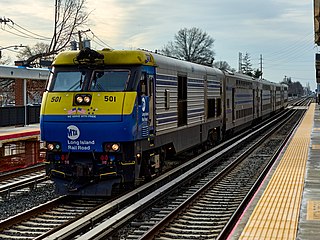
The EMD DE30AC and DM30AC are a class of 46 locomotives built between 1997–1999 by Electro-Motive Division in the Super Steel Plant in Schenectady, New York, for the Long Island Rail Road of the Metropolitan Transportation Authority (MTA) in New York. Originally divided equally between the two types, the fleet currently consists of 24 DE30AC locomotives and 20 DM30AC locomotives.

The Pennsylvania Railroad's MP54 was a class of electric multiple unit railcars. The class was initially constructed as an unpowered, locomotive hauled coach for suburban operations, but were designed to be rebuilt into self-propelled units as electrification plans were realized. The first of these self-propelled cars were placed in service with the PRR subsidiary Long Island Rail Road with DC propulsion in 1908 and soon spread to the Philadelphia-based network of low frequency AC electrified suburban lines in 1915. Eventually the cars came to be used throughout the railroad's electrified network from Washington, D.C. to New York City and Harrisburg, Pennsylvania.

The Budd Metroliner was a class of American electric multiple unit (EMU) railcar designed for first-class, high-speed service between New York City and Washington, D.C., on the Northeast Corridor. They were designed for operation up to 150 miles per hour (240 km/h): what would have been the first high speed rail service in the Western Hemisphere. Although 164 mph (264 km/h) was reached during test runs, track conditions and electrical issues limited top speeds to 120 mph (190 km/h) in revenue service. The single-ended units were designed to be arranged in two-car sets, which were in turn coupled into four to eight-car trains.

The Jersey Arrow is a type of electric multiple unit (EMU) railcar developed for the Pennsylvania Railroad, and used through successive commuter operators in New Jersey, through to NJ Transit. Three models were built, but only the third model is in use today. The series is similar to SEPTA's Silverliner series, but include center doors among other differences in details.
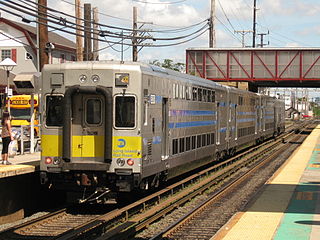
The C3 is a bi-level coach railroad car built by Kawasaki. Ordered by the Metropolitan Transportation Authority for use on the Long Island Rail Road (LIRR), the cars began to enter revenue service in 1997. The rail cars are pulled and pushed by EMD DE30AC and DM30AC dual-mode locomotives. The C3 cars are powered by 480 V AC head-end power supplied from the locomotive.

Silverliner is the name given to a series of electric multiple unit (EMU) railcars in commuter rail service in the Philadelphia area since 1958. As of the introduction of the Silverliner V in 2009–2010, there have been 5 generations of Silverliner cars, identified by the Roman numerals I through V placed after the name Silverliner. The Silverliner name came from the classes' shiny stainless steel body shell, which contrasted with the painted and frequently rusting carbon steel railcars used by the Pennsylvania and Reading Railroads between 1915 and 1936. Applied to the first large production order in 1963, the cars made such an impression that the name has since been applied to all subsequent MU classes purchased by SEPTA for the Regional Rail services.
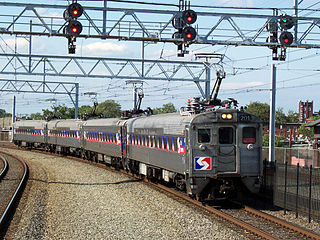
The Budd Silverliner was a model of electric multiple unit railcar designed and built by the Budd Company with 59 examples being delivered starting in 1963. Fifty-five of the cars were purchased for the Reading and Pennsylvania Railroads with public funds for use in Philadelphia, Pennsylvania, area commuter rail service with the remaining 4 cars being purchased by USDOT for use in high-speed rail experiments in 1965. Based on a series of 6 prototype Pioneer III cars built in 1958, the Silverliners represented the first production order of "modern" commuter MU equipment purchased by either railroad and earned their name from their unpainted stainless steel construction which contrasted with the painted carbon steel bodies of the pre-war MU fleets. The cars became a fixture of SEPTA Regional Rail service providing the name to their entire series of EMU railcars before finally being retired in 2012 after 49 years in service.
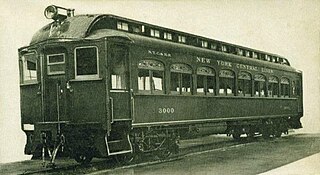
The New York Central MU Cars were a series of Electric Multiple Units built for the New York Central Railroad in 1906–1929 when the New York Central began electrifying its lines for both the Hudson Division and the Harlem Division.
The Metro-North Railroad is a commuter railroad serving northern suburbs of New York City. It principally uses a fleet of electric railcars for its services; diesel locomotives and push-pull coaches are in use as well for non-electrified portions of the system.

The Silverliner IV is the fourth-generation electric multiple unit railcar in the Silverliner family. It was designed and built by General Electric and was delivered between 1973 and 1976. It operates on the SEPTA Regional Rail network throughout Greater Philadelphia.
